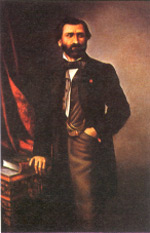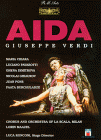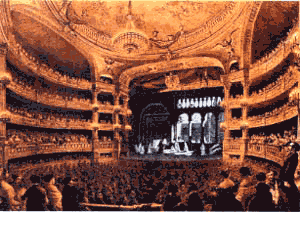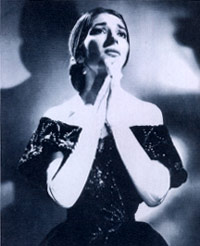|
 He was born into a family of small landowners and taverners. When he was seven he was helping the local church organist; at 12 he was studying with the organist at the main church in nearby Busseto, whose assistant he became in 1829. He already had several compositions to his credit. In 1832 he was sent to Milan, but was refused a place at the conservatory and studied with Vincenzo Lavigna, composer and former La Scala musician. He might have taken a post as organist at Monza in 1835, but returned to Busseto where he was passed over as maestro di cappella but became town music master in 1836 and married Margherita Barezzi, his patron's daughter (their two children died in infancy).
He was born into a family of small landowners and taverners. When he was seven he was helping the local church organist; at 12 he was studying with the organist at the main church in nearby Busseto, whose assistant he became in 1829. He already had several compositions to his credit. In 1832 he was sent to Milan, but was refused a place at the conservatory and studied with Vincenzo Lavigna, composer and former La Scala musician. He might have taken a post as organist at Monza in 1835, but returned to Busseto where he was passed over as maestro di cappella but became town music master in 1836 and married Margherita Barezzi, his patron's daughter (their two children died in infancy).
 Verdi had begun an opera, and tried to arrange a performance in Parma or Milan; he was unsuccessful but had some songs published and decided to settle in Milan in 1839 where his Oberto was accepted at La Scala and further operas commissioned. It was well received but his next, Un giorno di regno, failed totally; and his wife died during its composition. Verdi nearly gave up, but was fired by the libretto of Nabucco and in 1842 saw its successful production, which carried his reputation across Italy, Europe and the New World over the next five years. It was followed by another opera also with marked political overtones, I lombardi alla prima crociata, again well received. Verdi's gift for stirring melody and tragic and heroic situations struck a chord in an Italy struggling for freedom and unity, causes with which he was sympathetic; but much opera of this period has political themes and the involvement of Verdi's operas in politics is easily exaggerated.
Verdi had begun an opera, and tried to arrange a performance in Parma or Milan; he was unsuccessful but had some songs published and decided to settle in Milan in 1839 where his Oberto was accepted at La Scala and further operas commissioned. It was well received but his next, Un giorno di regno, failed totally; and his wife died during its composition. Verdi nearly gave up, but was fired by the libretto of Nabucco and in 1842 saw its successful production, which carried his reputation across Italy, Europe and the New World over the next five years. It was followed by another opera also with marked political overtones, I lombardi alla prima crociata, again well received. Verdi's gift for stirring melody and tragic and heroic situations struck a chord in an Italy struggling for freedom and unity, causes with which he was sympathetic; but much opera of this period has political themes and the involvement of Verdi's operas in politics is easily exaggerated.
 The period Verdi later called his 'years in the galleys' now began, with a long and demanding series of operas to compose and (usually) direct, in the main Italian centres and abroad: they include Ernani, Macbeth, Luisa Miller and eight others in 1844-50, in Paris and London as well as Rome, Milan, Naples, Venice, Florence and Trieste (with a pause in 1846 when his health gave way). Features of these works include strong, sombre stories, a vigorous, almost crude orchestral style that gradually grew fuller and richer, forceful vocal writing including broad lines in 9/8 and 12/8 metre and above all a seriousness in his determination to convey the full force of the drama. His models included late Rossini, Mercadante and Donizetti. He took great care over the choice of topics and about the detailed planning of his librettos. He established his basic vocal types early, in Ernani the vigorous, determined baritone, the ardent, courageous but sometimes despairing tenor, the severe bass; among the women there is more variation. The period Verdi later called his 'years in the galleys' now began, with a long and demanding series of operas to compose and (usually) direct, in the main Italian centres and abroad: they include Ernani, Macbeth, Luisa Miller and eight others in 1844-50, in Paris and London as well as Rome, Milan, Naples, Venice, Florence and Trieste (with a pause in 1846 when his health gave way). Features of these works include strong, sombre stories, a vigorous, almost crude orchestral style that gradually grew fuller and richer, forceful vocal writing including broad lines in 9/8 and 12/8 metre and above all a seriousness in his determination to convey the full force of the drama. His models included late Rossini, Mercadante and Donizetti. He took great care over the choice of topics and about the detailed planning of his librettos. He established his basic vocal types early, in Ernani the vigorous, determined baritone, the ardent, courageous but sometimes despairing tenor, the severe bass; among the women there is more variation.
 The 'galley years' have their climax in the three great, popular operas of 1851-3. First among them is Rigoletto, produced in Venice (after trouble with the censors, a recurring theme in Verdi) and a huge success, as its richly varied and unprecedentedly dramatic music amply justifies. No less successful, in Rome, was the more direct Il trovatore, at the beginning of 1853; but six weeks later La traviata, the most personal and intimate of Verdi's operas, was a failure in Venice - though with some revisions it was favourably received the following year at a different Venetian theatre. With the dark drama of the one, the heroics of the second and the grace and pathos of the third, Verdi had shown how extraordinarily wide was his expressive range.
The 'galley years' have their climax in the three great, popular operas of 1851-3. First among them is Rigoletto, produced in Venice (after trouble with the censors, a recurring theme in Verdi) and a huge success, as its richly varied and unprecedentedly dramatic music amply justifies. No less successful, in Rome, was the more direct Il trovatore, at the beginning of 1853; but six weeks later La traviata, the most personal and intimate of Verdi's operas, was a failure in Venice - though with some revisions it was favourably received the following year at a different Venetian theatre. With the dark drama of the one, the heroics of the second and the grace and pathos of the third, Verdi had shown how extraordinarily wide was his expressive range.


|